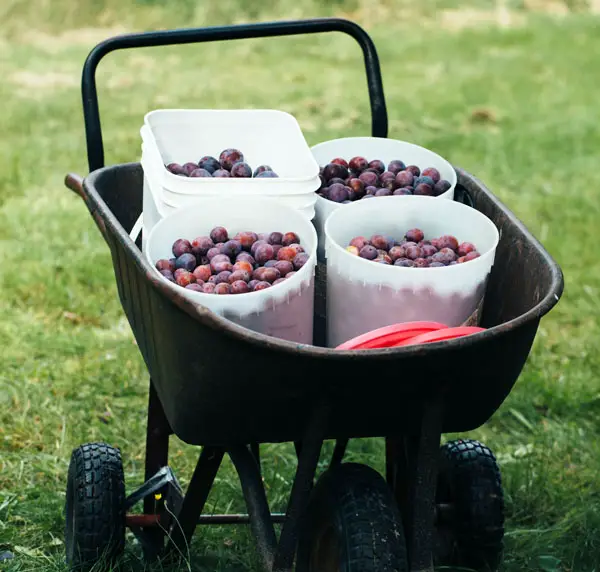Although called Plum Sawfly, these plum pests aren’t damaging to just plums – they can also be harmful to apples, pears, and cherry trees.

Plum sawfly pupate in the soil and then they emerge between May and June. The larvae found on the leaves are black or olive green colour and these pests aren’t as common as plum moths.
Trees infected with plum sawfly may have obvious leaf curl, they may turn brown and look diseased, and part of the leaf may be eaten away or appear transparent. There are a few plum varieties that appear to be more susceptible to plum sawfly – Victoria and Czar, to name a few.
Jump To...
Fruit Trees Vulnerable to Plum Sawfly
Plum trees are hardier than other fruit trees but of course, pests can prove to be a problem among them. Below we name some of the fruit trees vulnerable to sawfly.
- Victoria Plum Trees
- Czar Plum Trees
- Apple Trees (Apple sawfly)
- Pear Trees (Pear sawfly)
- Cherry Trees (Cherry Sawfly)
- Apricot Trees (Apricot Sawfly)
- Hawthorn Trees (Hawthorn Sawfly)
Plum Sawfly Identification – Lifecycle
A Plum Sawfly infestation can be difficult to spot. These fruit pests can be found in different forms and in different locations depending on the time of year.
To help with identification, here’s what they look like during the growing season and when you should be looking out for those telltale signs of an infestation.
Early Spring
Sawfly pupae overwinter in the soil below trees and the adult flies will emerge from the soil around the base of the tree. They will then lay eggs on the Plum tree leaves, which the larvae will feed on.
Late Summer
Once the larvae are fully fed, they will drop back into the soil, pupate, and repeat the lifecycle, with a second generation of sawflies emerging to repeat the process around August.
Autumn
The sawfly larvae will drop into the soil once more and will hibernate there until the warmer weather of spring warms the soil. They’ll wake up and hit the plum tree buffet again.
Plum Sawfly Damage
Plum sawfly can be tricky to spot early on if you only have a small infestation. However, there are some tell-tale signs of damage which we’ve listed below.
- Plum leaf curl may occur and can indicate you have a plum sawfly problem. The sawfly present on the tree causes the leaves to fold.
- Transparency on the leaves can be another indication of plum sawfly. Here, the veins of the leaves should be crystal clear.
- You may find some leaves on the tree have been completely eaten, leaving only the skeleton of the leaf behind.
Plum Sawfly Treatment & Control
Trained eyes can pick up plum sawfly early on which can mean your tree can remain healthy and still yield well. There are also some treatments you can use and steps you can take to control plum sawfly.
You have a choice between non-pesticide controls which are kinder to other wildlife and pesticide controls. Often, if the infestation isn’t severe, you can opt for a less harsh solution.
Non Pesticide Control
If you have caught the plum sawfly issue early on then a non-pesticide control approach is recommended. Below, we include the most common non-pesticide solutions:
- Spray the leaves of the tree with a dilute soap solution, a few drops of washing up liquid in water will do the trick. Repeat this process every 2-3 days for a couple of weeks until the infestation clears. Alternatively, use a horticultural fatty acid which you can buy at a garden centre.
- Wildlife is your friend when it comes to sawfly so by encouraging predators such as birds, other insects, and animals you have a natural solution. So grow those wild flowers, keep sections of grass long, and make yourselves a wildlife-friendly garden.
- You can also try turning over the soil around the tree in February time which should bring the sawfly to the surface. They will then be eaten by other forms of wildlife such as birds.
- You can, of course, inspect your trees regularly and remove any visible larvae by hand.
- Place your tree in a prime bird-loving spot so that the birds are actively feeding from your tree.
Pesticide Control
Should your sawfly infestation be more severe, you may need to resort to a chemical pesticide. After all, it can be heartbreaking putting in the effort needed to grow and develop a fruit tree then to watch it be destroyed.
- Products with the ingredient Pyrethrum will all be successful in treating sawfly. This does involve thorough spraying though, of the entire tree for it to be worthwhile.
- Sometimes such treatment needs to be repeated a few weeks later and it’s always important to follow the directions on the spray.
- Be sure to clean fruit thoroughly before consumption when using pesticides.
- Flowering plants shouldn’t be sprayed as you risk killing pollinators such as bees.
Our guide to plum pests and diseases will help you identify and avoid common plum tree problems, and provide treatment information.

